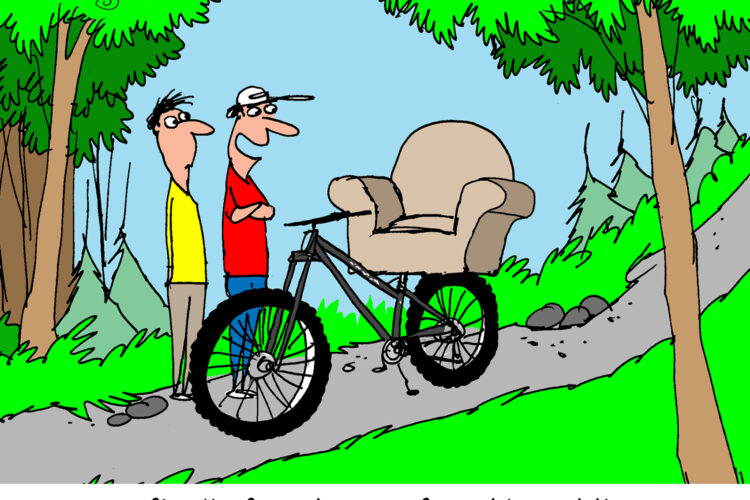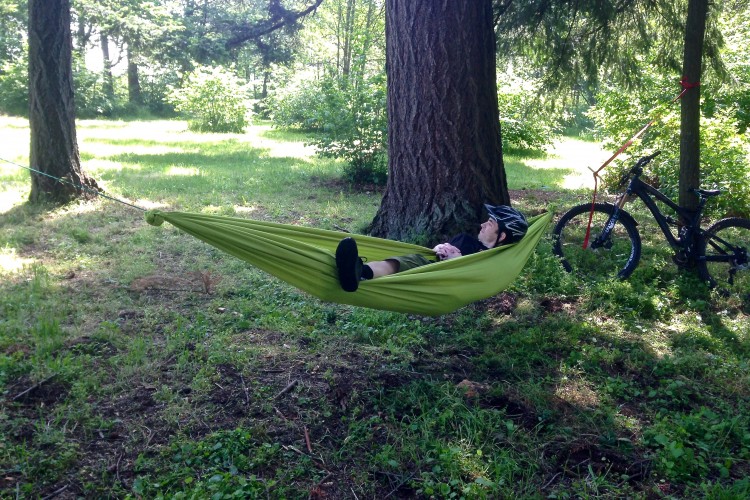
So, you’re planning on purchasing or assembling your dream bike for the upcoming MTB season. What size should you choose? How long of a stem do you need? Should you get a setback seatpost? What’s the right bar width? I’ll try to answer all these questions and more in this article on mountain bike fitting.
Most bike shops do a good job helping customers find the right frame size and you can always double check by taking a peek at the bike manufacturer’s website or catalog. The size chart below is an example and as you can see there is a range for every frame size. Beyond height, this chart doesn’t take into account specific body measurements (torso size, leg length, etc.) and that’s where component fitting comes in.

So… it’s really up to you to get the perfect fit. Some bike shops offer fittings, usually at a cost nowadays (not including parts which is an additional cost). But looking at your body and sitting on the bike with someone holding you on, you can get a good idea of what fits or what feels best for you. But before you spend your cash, let’s cover the list of things we can change on the bike, what those changes will feel like, and what a retailer shop should be able to do to accommodate you when you purchase that shiny new bike.
Mountain Bike Frame Size: #1 Most Important Item
Getting the right mountain bike frame size is paramount. If you’re in between sizes and are planning on really riding rough, you may want the smaller size rather than the larger (easier to bail when things go wrong). Use a sizing chart to get an idea of where you fit, then check the actual bike. Hop on the bike and if possible, go for a test ride. You should also be able to get a sense of what’s going on with the fit just by sitting on the bike and pedaling backward.
At this point you should feel more or less comfortable: not up too high and stretched or too low and cramped. You should also be able to place your feet flat on the ground when you dismount the bike. Stand over height is a bit more difficult to gauge these days due to the newer, sloping top tube frames which give the illusion that the frame is smaller than it is. Instead, I focus my attention on the top tube length.

To find the right seat tube length, take your inseam (legs 6 inches apart) and multiply by .67 then subtract 4 inches. For example I have a 33 inch inseam. Multiplied by .67 I get 21.75 inches, take 4- 5 inches away I end up with a 17.5 inch frame set (which happens to be what I use).



Mountain Bike Handlebar Width
Sometimes due to your specific body type or riding style a wider than stock bar can be a good choice. As the handlebars widens, it allows more steering torque (great for nasty terrain) and slows your steering down. A bar change on its own will also pull you forward a bit. A wider bar also makes it easier to breathe as it encourages you to open your chest more when huffing up a hill. The good news is that most bike shops are willing to change to a wider bar if necessary. Once you have your bar width, work on shifter and brake positioning. Try to set both so your wrist is not bent in an awkward angle and there is a small degree of freedom there – about 15 degrees. Anything more than that and you are at risk of hurting yourself.


Mountain Bike Stem Length
Riders with disproportionate leg to torso sizes will want to take a look at changing up stem length for a more comfortable riding posture. A longer stem typically pulls the rider forward and flattens the back. The result is slowed steering and more traction to the front wheel.
Shortening the stem moves the rider toward the center of the bike and adds curvature to the back, leading to a more upright riding position. Ideally the rider should have elbows slightly bent when riding straight ahead which acts as a natural upper body shock absorber. Proper stem length and positioning alleviates upper body soreness and removes excessive force from the wrists. Most XC stems range in length from 70mm to 130mm. AM and DH stems can range from as short as 25mm to about 55mm+.


Handlebar height
You may find that your handlebars are too low or high. By adjusting bar height you’re trying to achieve:
- A comfortable back angle, depending on your degree of flexibility.
- A natural feel to look ahead without craning your neck.
There are a few solutions here. Firstly take a look at where your stem meets your steering tube. You may see a few spacers – if so great! You can adjust the shim stack position relative to the frame which will raise or lower the stem and bar. For example, placing all the shims below the stem will raise your bar up by that amount. If you don’t have shims, you may need to get either a riser bar or a riser stem. Easton sells the EA50 stem with either 6 or 20 degrees of rise. You can also choose from flat bars, mid rise bars (about 20mm), or full rise bars (from 35mm to 45mm depending on the model).
Seat post height and setback
Once you have the right frame size it’s time to set the seat post height and setback (for you folks who ride DH, FR, and DJ this does not apply). Starting with the seat parallel with the ground, set the cranks so that they are in line with your seat tube, projecting a straight line through the BB and to the floor. Hop on the bike and have someone support you while you position your feet on the pedals – ball of the foot on the axle and foot slightly pointing forward a couple degrees. You should not have your leg fully extended – there should be about 10-15 degrees of movement before your leg locks straight.
You can also use this formula as a decent starting point: Take your inseam measurement and multiply by .883. The result is the ballpark measurement from the top of the lower pedal center of the bottom bracket to the top of the saddle. From here you may need to go up or down a quarter of an inch until it looks and feels right.


With the basic seat height position set, it’s time to check positioning front to back. With the cranks set at 3 and 9 o’clock, get a piece of string and tie a weight to it. Sit on the bike in your riding position and pedal backwards a few strokes and stop at 3 and 9 o’clock again (you’ll need a spotter to help). Hang a plumb line or weighted string from your tibial tuberosity (bony protrusion just below your knee cap) and have a look at where the string intersects your crank – it should fall right in line with the pedal axle. If the string falls forward or behind, just slide the seat on the post to fix your positioning.
If you can’t adjust the seat far enough you may need to change your seatpost offset. There are seatpost offset options you can purchase from zero offsets all the way to 25mm offsets (see images below).


Crank arm length
You may want to consider changing up your crank arm length as well. Most manufacturers offer MTB cranks from 165mm to 180mm, usually in 5mm increments, and stock cranks may be too long for many riders. The proper crank arm length is typically dependent on the rider’s height and inseam. So a short person (5′ – 5′.5″) may want to consider 165- 170mm cranks. For someone from 5′.5″ – 5′ 10″, a 175mm usually works well and taller folks may want to consider 175mm+ cranks. Now if you have short legs, a shorter crank arm may be a better choice. Or if you’re a quick peddler, a shorter crank arm may be the way to go as well.
Now Get in Your Comfort Zone
This next section will help you consider a few items that can give you that “at one” feeling with your bike. There are really just 3 spots where body meets machine: handlebar grips, saddle, and pedals.
Handlebar grips
Before we talk about bar grips you should understand the two basic classes of grips. There are the lock-on types that are gaining popularity and the conventional style that holds onto the bar with friction. The difference? About $20. Seriously though, locking grips do work a bit better because they don’t slip and are easily removed and installed using an allen key to tighten.
Saying all that, there many MTB grip choices on the market today. When choosing consider a few things: What is your riding style? Are you an epic kinda person who will spend hours on the bike or are you a DH / FR type who needs maximum grip?

Pedal and cleat positions
Setting up your cleats is probably (in my opinion) the second most important fitting task. After all, the wrong pedal cleat positioning will increase strain in the knee and results in a less-than-ideal pedal stroke. Ideally you want the cleat set up so that if you draw a line from the center of the pedal axle up it will intersect with the widest part of your foot (where you apply the most force).

Use a mirror to take a look at the front of your feet and make sure they run parallel with your crank arms. This position will ease the load on your knee and ensures your feet will release from the pedals. One final note: many pedals feature adjustable tension and it’s often a good idea to start with the lightest tension where your feet barely wiggle (float). What you don’t want is a super solid feel to the pedal-shoe interface that hinders your foot’s natural tendency to twist on the back stroke.



Mountain Bike Saddle
Selecting the right MTB saddle depends on a few things. For one, consider the type of riding you’ll be doing: racing, long epic rides, DH, etc. Do you need extra padding because your current saddle is killing you?
Aside from padding and support, take a look at saddle width. In short, your pelvic bone should match up to the widest part of the saddle. So if a saddle feels good, it’s probably the proper size for you. You can also measure your sit bone width to find the right saddle size.
This is by no means a definitive article on bike fitting but it’s based on years of personal experience fitting myself and others on their bikes. If you have question feel free to ask and I can clarify further as there are many more variables that can change a measurement or two in relationship to what was mentioned in this article.
A quick thanks to the good folks at OPUS for the sizing chart.
Cheers!


















